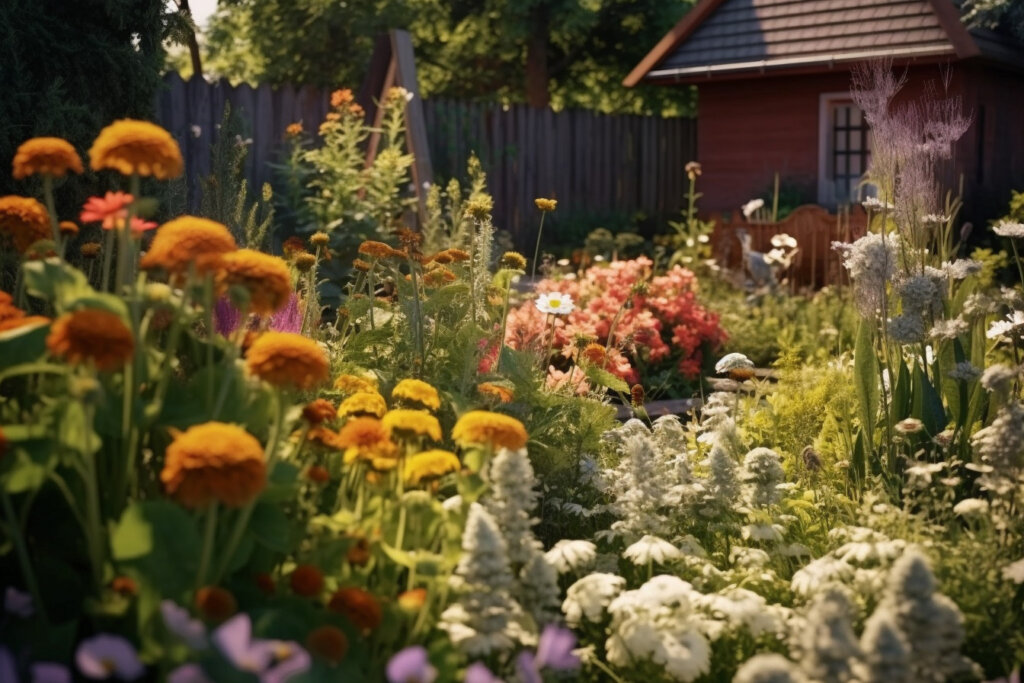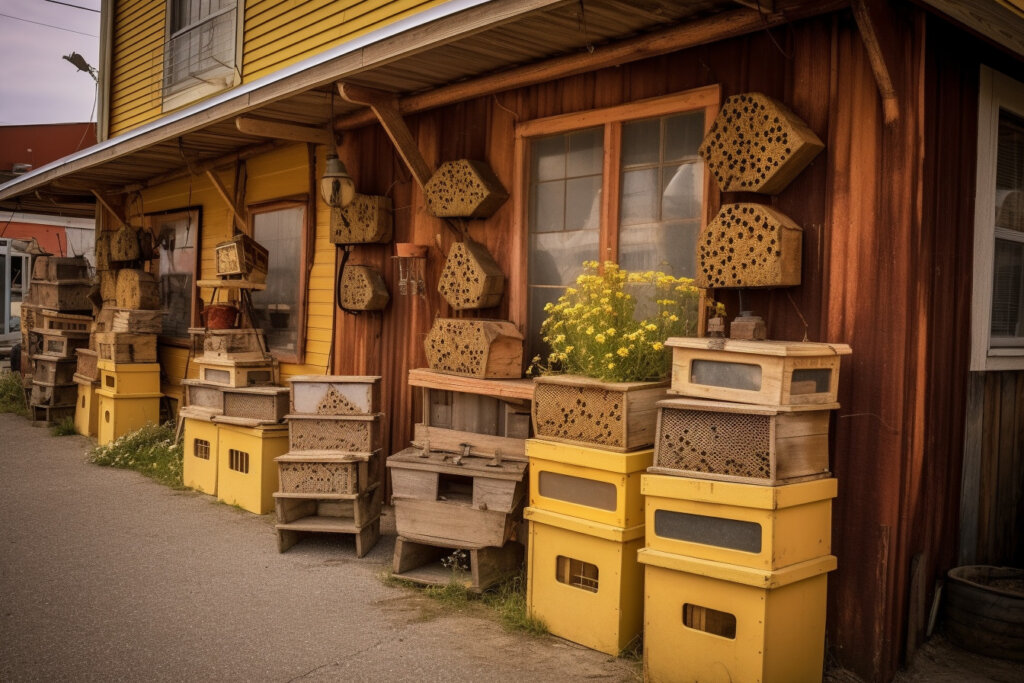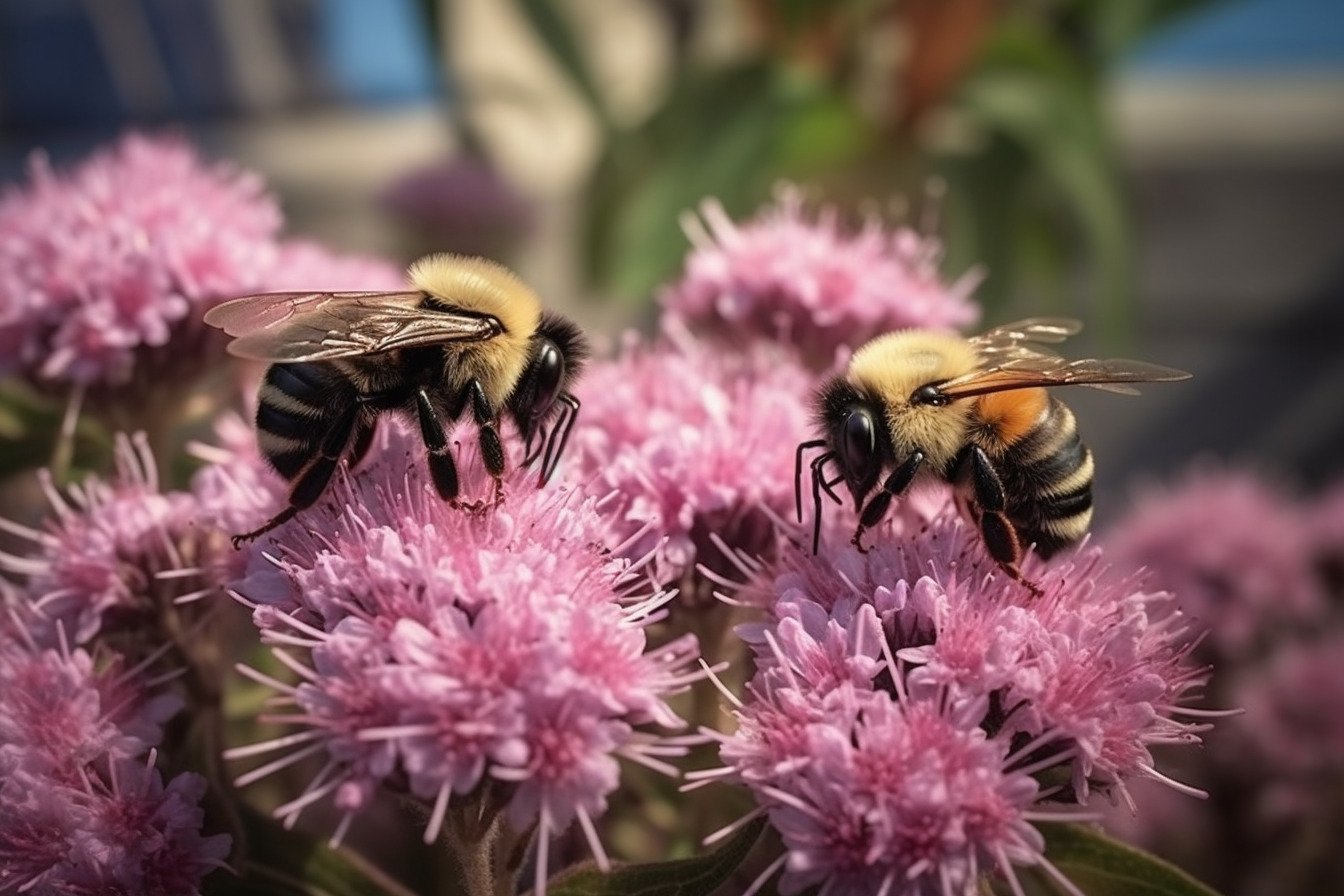Welcome to our guide on transforming your backyard into a sanctuary for one of nature’s most industrious pollinators: the bumble bee. If you’ve been considering ways to contribute positively to your local ecosystem, creating a bee-friendly garden is an excellent start. It’s an initiative that not only fosters biodiversity but also enhances the productivity and aesthetic appeal of your garden.
The Importance of Bumble Bees in the Ecosystem
The Role of Bumble Bees in Pollination
Bumble bees are critical pollinators in our ecosystems. As they travel from flower to flower, they help in the reproduction of many plant species by transferring pollen. This process is vital for the production of fruits, seeds, and vegetables. Without pollinators like the bumble bee, our gardens, meadows, and farms would be far less productive and colorful.
Furthermore, bumble bees, with their larger bodies and ability to ‘buzz pollinate’, are uniquely suited to pollinate certain types of plants that other insects cannot. For example, the flowers of tomatoes and blueberries release their pollen more readily when vibrated by bumble bees – a process known as buzz pollination or sonication.
The Current Status of Bumble Bee Populations and the Threats They Face
Despite their importance, bumble bee populations are facing significant threats. Factors such as habitat loss, climate change, pesticide exposure, and diseases have led to a decline in their numbers. This is concerning, given the crucial role they play in our ecosystems and food production.
Recent studies indicate that nearly a quarter of all bumble bee species are facing some degree of extinction risk. The rapid decline in their population emphasizes the urgent need for initiatives to protect and conserve these invaluable pollinators. One such initiative we can all partake in is the creation of bumble bee-friendly gardens. In the next sections, we’ll guide you through the steps of transforming your backyard into a haven for bumble bees.
Benefits of Creating a Bumble Bee Sanctuary in Your Backyard
Promoting Biodiversity
Creating a bumble bee sanctuary contributes significantly to local biodiversity. Bumble bees, like other pollinators, help maintain the health and variety of local ecosystems. As they move pollen from one flower to another, they facilitate the reproduction of a wide range of plants, many of which provide food and shelter for other wildlife.
By attracting bumble bees, your garden becomes part of a larger network of habitats that support these essential pollinators, contributing to the overall health of your local environment. Furthermore, a bee-friendly garden often attracts other beneficial insects and birds, thus further enhancing your local biodiversity.
Enhancing the Productivity of Your Garden
Apart from the environmental benefits, a bee-friendly garden can enhance the productivity of your garden. By attracting bumble bees, you ensure efficient pollination of your flowering plants. This leads to healthier plants and more abundant yields, especially if you grow fruits, vegetables, or have flowering trees and shrubs.
The presence of bumble bees can also improve the quality of your harvest. For instance, research shows that buzz pollination by bumble bees can lead to larger and more flavorful fruits in crops like tomatoes and blueberries.
Understanding Bumble Bee Preferences
Before we delve into transforming your garden, it’s important to understand what bumble bees are looking for. Just like any other creature, bumble bees have specific habitat requirements and preferences. In the following sections, we’ll discuss these preferences and how we can use this knowledge to create a bumble bee sanctuary in your backyard.
Bumble Bee Habitat Requirements
Overview of Bumble Bees’ Nesting and Foraging Needs
Bumble bees have two primary habitat needs: nesting and foraging. Understanding these needs is key to creating a welcoming environment in your garden.
- Nesting: Bumble bees typically nest in quiet, undisturbed spaces. Different species have different preferences: some like to nest underground in abandoned rodent burrows, others prefer tall grass or piles of leaves and compost, while some may even use birdhouses. They don’t travel far from their nest to forage, so the closer you can provide food sources, the better.
- Foraging: For their food, bumble bees depend on flowers for nectar, their source of energy, and pollen, their source of protein. They tend to favor flowers that are open and tubular, with bright, warm colors like yellow, violet, and blue.
Importance of Providing a Diverse Plant Selection
Just as we need a varied diet to get all our necessary nutrients, bumble bees also require a diversity of pollen and nectar sources for optimal health. A diverse plant selection not only provides a balanced diet for bees but also ensures a continuous food supply throughout the season.
Choosing a mix of flowering plants that bloom at different times, from early spring through late fall, is crucial to provide nectar and pollen as long as possible. Early spring flowers help queens that have just emerged from hibernation, while late bloomers provide sustenance for new queens preparing to hibernate.
In the next sections, we’ll provide some guidance on choosing bee-friendly plants and how to arrange them in your garden to maximize their appeal to bumble bees.
Choosing Plants Bumble Bees Love

Identifying Bee-Friendly Plants: Native Flowers, Herbs, and Shrubs
Selecting the right plants is key to attracting bumble bees. Here are some criteria to keep in mind:
- Native Plants: Native plants are always a good choice because they’ve co-evolved with local bumble bee species, making them a perfect match for each other’s needs. Examples of native flowers bumble bees love include cone flowers (Echinacea), bee balm (Monarda), and lupines (Lupinus).
- Herbs: Many common herbs are attractive to bees, including lavender, sage, thyme, and mint. Plus, they’re useful for your kitchen!
- Shrubs and Trees: Don’t forget about larger plants. Shrubs like blueberries and blackberries, as well as flowering trees such as crabapples, can provide abundant food for bumble bees.
Always remember to choose plants that are free of pesticides, as these can harm bumble bees.
Planting for a Continuous Bloom: Ensuring Nectar and Pollen Throughout the Seasons
For a bee-friendly garden, it’s essential to plan for a continuous bloom. This means selecting a variety of plants that flower at different times, providing a constant source of nectar and pollen.
In the spring, consider planting bulbs like crocus and snowdrops, and trees like willow and cherry. For the summer, borage, lavender, and salvia are excellent choices. In the fall, asters and goldenrods can provide late-season sustenance.
This way, you ensure that no matter the season, your garden will be buzzing with activity.
Practical Steps to Transform Your Backyard into a Bumble Bee Sanctuary
Now that we’ve established the importance of bumble bees and understood their preferences, it’s time to discuss the practical steps you can take to transform your backyard into a bumble bee sanctuary. In the next sections, we’ll delve into the process of designing your garden layout, selecting and maintaining your plants, and providing safe nesting spaces for bumble bees.
Designing the Garden for Bumble Bees
Landscape Considerations: Sun Exposure, Soil Type, Water Sources
When designing your garden, there are several key considerations to make it attractive to bumble bees:
- Sun Exposure: Most bee-friendly plants need lots of sunlight, so try to select a site with full sun to partial shade. However, also consider including some shaded areas as bumble bees sometimes need to cool down on hot days.
- Soil Type: Different plants have different soil preferences. However, many plants that are attractive to bees are quite adaptable. Aim for well-drained soil and consider adding organic matter to enrich it.
- Water Sources: Bumble bees need water, especially in the summer. Consider adding a shallow dish with stones for them to land on, or a birdbath with landing spots.
Arrangement of Plants: Clustering Similar Plants, Incorporating Variety of Heights
The way you arrange your plants can also impact their attractiveness to bumble bees:
- Clustering Similar Plants: Planting in clusters of the same species makes your garden more visually appealing to bumble bees and also more efficient for them to forage. Try to have at least a square meter of each plant type.
- Incorporating Variety of Heights: Including plants of different heights not only adds interest to your garden but also caters to different bumble bee species that prefer to forage at different levels.
Planting and Maintenance Tips
Organic Gardening Methods for a Bee-Friendly Garden
Using organic methods is essential for maintaining a bee-friendly garden. Here are some tips:
- Avoid Pesticides: Many pesticides are harmful to bees. Instead, use organic pest control methods such as encouraging beneficial insects and birds.
- Compost: Enrich your soil with compost instead of chemical fertilizers. This not only provides excellent nutrients for your plants but also improves soil structure and water retention.
Water Provision and the Importance of Leaving Some Areas Untidy
- Water Provision: As mentioned earlier, bees need water. Fill a shallow dish or birdbath with water and provide stones or twigs as landing spots.
- Leaving Areas Untidy: Resist the urge to tidy up too much. Bumble bees often nest in undisturbed corners, tall grass, and piles of leaves or compost.
Providing Safe Nesting Spaces for Bumble Bees
Creating a successful bumble bee sanctuary goes beyond just providing food; it also involves providing safe and suitable spaces for bumble bees to establish their nests. The next sections will guide you on the natural nesting habits of bumble bees and how you can create artificial nesting sites to encourage these fascinating creatures to call your garden home.
Natural Nesting Habits of Bumble Bees
Understanding Different Species’ Preferences: Underground, Grass, Wood Piles
Bumble bees are diverse, with different species having distinct nesting preferences. Some common nesting habitats include:
- Underground: Many bumble bee species prefer to nest underground, often in old rodent burrows. These bees may be attracted to compost piles or untidy corners of the garden that resemble their natural habitats.
- Grass: Some bumble bees nest in grassy areas, particularly in tall or overgrown grass. Leaving a section of your lawn un-mowed, especially if it includes clover or other flowering plants, can be inviting to these bees.
- Wood Piles: A few species nest above ground in cavities, which can include tree stumps, piles of wood, or even disused birdhouses. Maintaining such features in your garden can provide additional options for nesting bumble bees.
Creating Artificial Nesting Sites
DIY Projects: Using Pots, Boxes, or Old Mouse Nests
Creating artificial nesting sites can be a fun and rewarding DIY project. Here are a few ideas:
- Flower Pots: Invert a terracotta flower pot in a quiet, shady corner of the garden, with a small hole in the soil for access.
- Wooden Boxes: A small wooden box with a narrow entrance hole, filled with nesting material like straw or wood shavings, can mimic natural cavities.
- Old Mouse Nests: If you come across an old mouse nest, consider leaving it in place as it may be adopted by a bumble bee queen in the spring.
Always remember to place your artificial nests in quiet, undisturbed areas of the garden.
Commercially Available Bee Houses

If DIY isn’t your thing, you can also purchase commercially available bee houses. These often incorporate features that are attractive to bumble bees, such as a narrow entrance to deter predators and a dry, insulated interior. Placing a few of these around your garden can boost your chances of attracting bumble bees.
Dealing with Potential Threats to Bumble Bees
Creating a bumble bee-friendly garden isn’t just about providing resources – it’s also about safeguarding them from potential threats. The following sections will help you understand the common predators and pests of bumble bees and suggest non-chemical pest control strategies that align with the goal of creating a bumble bee sanctuary in your garden.
Common Predators and Pests of Bumble Bees
Identifying Threats: Wasps, Mites, Birds, and Mammals
Bumble bees, like any other creatures, face threats from various predators and pests. Some common threats include:
- Wasps: Wasps can pose a threat to bumble bees as they may raid nests for larvae. Certain wasps are known to kill the bumble bees and take over their nests.
- Mites: Mites, particularly the parasitic mite Locustacarus buchneri, can infest bumble bees and their nests, leading to weakened colonies.
- Birds: Some bird species, such as starlings, are known to prey on bumble bees.
- Mammals: Badgers and foxes can also disturb bumble bee nests, digging them up to feed on the bees and larvae.
It’s important to balance the need to protect bumble bees with the broader goal of promoting biodiversity, as many of these predators are also part of the ecosystem.
Non-Chemical Pest Control Strategies
Integrated Pest Management (IPM) Approach
Integrated Pest Management (IPM) is a comprehensive, environmentally sensitive approach to pest control that emphasizes non-chemical methods:
- Monitor and Identify Pests: Not all insects are harmful, so it’s important to identify the pests before taking action. Regular monitoring can help detect any problems early.
- Prevention: The best way to manage pests is to prevent them from becoming a problem in the first place. This can be achieved by creating a diverse garden, which encourages a range of beneficial insects and other wildlife.
- Control: If pests become a problem, non-chemical methods should be the first step. This can include hand-picking pests, using water sprays to dislodge pests, or employing natural predators.
Planting Pest-Deterring Plants and Employing Beneficial Insects
- Pest-Deterring Plants: Certain plants, like marigolds and garlic, are known to deter pests and can be incorporated into your garden design.
- Beneficial Insects: Encouraging beneficial insects, such as ladybugs, spiders, and certain types of wasps, can help control pest populations. This can be achieved by planting a variety of plants to provide food and habitat for these beneficial insects.
The Impact of a Bumble Bee Sanctuary
After all the effort of creating a bumble bee sanctuary in your backyard, it’s worthwhile to take a moment to reflect on the impact of your work. This final section will discuss the positive effects on local ecosystems, the contribution to bumble bee conservation efforts, and the personal joy and educational value of hosting these buzzing guests in your garden.
Observing Your Busy Bumble Bees
Noticing Patterns in Bee Behavior and Plant Preference
Once you have your garden buzzing with bumble bees, it’s a joy to watch them go about their business. Pay close attention to their behavior – you may notice patterns such as which flowers they seem to prefer, what times of day they are most active, or even spot the larger queen bees amongst the workers. This not only enriches your personal experience but also helps you better cater to their needs.
Engaging in Citizen Science: Reporting Your Observations to Help Researchers
Your observations can be of great value to scientists studying bumble bees. Consider contributing to citizen science projects where you can report on the bees visiting your garden. This data can help researchers track changes in bumble bee populations and distributions, and can contribute to conservation efforts.
Encouraging Others to Create Bee-Friendly Gardens
Sharing Your Experience with Your Community
Once you’ve transformed your own backyard into a bumble bee sanctuary, why not inspire others to do the same? Share your experience with friends, neighbors, and local gardening clubs. Show them how beautiful a bee-friendly garden can be and the enjoyment you get from watching your busy bees.
Advocacy for Local Policies That Support Pollinators
At a larger scale, consider advocating for local policies that support pollinators. This could involve initiatives such as reducing pesticide use in public spaces, promoting the planting of native species, or creating habitats for bees in parks and other green areas.
Conclusion
Recap of the Importance and Benefits of a Bee-Friendly Garden
Creating a bee-friendly garden is a rewarding endeavor on many levels. Not only does it contribute to the conservation of these important pollinators, but it also enhances your garden’s productivity and beauty. Observing the behavior of these fascinating creatures can provide endless fascination and a deep connection to the natural world.
Encouragement for Ongoing Maintenance and Observation of Your Bumble Bee Sanctuary
Remember, a bumble bee sanctuary needs ongoing care and observation. Continue to adapt your garden to the bees’ needs and watch how it evolves over time. Every year can bring new insights and new joys.
By transforming your backyard into a haven for bumble bees, you’re playing an important part in conserving these remarkable creatures and the ecosystems they support. So, enjoy your buzzing backyard, and take pride in knowing that you’re making a difference.
